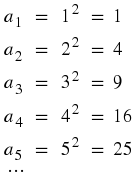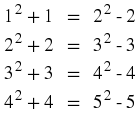A sequence does not have to follow a pattern but when it does, we can often write down a formula to calculate the
n
th
-term,
a
n
. In the sequence
(1.1)
1
;
4
;
9
;
16
;
25
;
...
where the sequence consists of the squares of integers, the formula for the
n
th
-term is
You can check this by looking at:
Therefore, using Equation 1.2, we can generate a pattern, namely squares of integers.
Exercise 1.2.1. Study Table continued .... (Go to Solution)
As before, you and 3 friends are studying for Maths, and you are seated at a square table. A few minutes later, 2 other friends join you and add another table to the existing one. Now 6 of you can sit together. A short time later 2 more of your friends join your table, and you add a third table to the existing tables. Now 8 of you can sit comfortably as shown:
Find the expression for the number of people seated at
n
tables. Then, use the general formula to determine how many people can sit around 12 tables and how many tables are needed for 20 people.
It is also important to note the difference between
n
and
a
n
.
n
can be compared to a place holder, while
a
n
is the value at the place “held” by
n
. Like our “Study Table” example above, the first table (Table 1) holds 4 people. Thus, at place
n = 1, the value of
a
1 = 4 and so on:
Table 1.2. |
n
| 1 | 2 | 3 | 4 | ... |
|
a
n
| 4 | 6 | 8 | 10 | ... |
Investigation : General Formula
Find the general formula for the following sequences and then find
a
10,
a
50 and
a
100:
2,5,8,11,14,...
0,4,8,12,16,...
2, – 1, – 4, – 7, – 10,...
The general term has been given for each sequence below. Work out the missing terms.
0;3;...;15;24
n
2 – 1
3;2;1;0;...; – 2 – n + 4
– 11;...; – 7;...; – 3 – 13 + 2n
In mathematics, a conjecture is a mathematical statement which appears to be true, but has not been formally proven to be true. A conjecture can be seen as an educated guess or an idea about a pattern.
For example: Make a conjecture about the next number based on the pattern 2;6;11;17 : ...
The numbers increase by 4, 5, and 6.
Conjecture: The next number will increase by 7. So, it will be 17 + 7 or 24.
Exercise 1.2.2. Number patterns (Go to Solution)
Consider the following pattern.
Add another two rows to the end of the pattern.
Make a conjecture about this pattern. Write your conjecture in words.
Generalise your conjecture for this pattern (in other words, write your conjecture algebraically).
Prove that your conjecture is true.












